 In the 1979 Vietnam War epic APOCALYPSE NOW, Frederic Forrest’s Chef warned us, “Never get out of the boat.” In 2007, VACANCY brings the warning closer to home: “Never get off the Interstate.” You see, you needn’t travel to the jungles of Vietnam to find hidden dangers waiting and even eager to kill you; they’re available in the highways and by-ways of America, located on winding roads in the middle of next to nowhere – places where the descendants of Norman Bates (and perhaps the distant cousins of the Texas Chainsaw family) continue to preside over isolated (and quite literal) roach motels, where guests check in but most definitely do not check out.
In the 1979 Vietnam War epic APOCALYPSE NOW, Frederic Forrest’s Chef warned us, “Never get out of the boat.” In 2007, VACANCY brings the warning closer to home: “Never get off the Interstate.” You see, you needn’t travel to the jungles of Vietnam to find hidden dangers waiting and even eager to kill you; they’re available in the highways and by-ways of America, located on winding roads in the middle of next to nowhere – places where the descendants of Norman Bates (and perhaps the distant cousins of the Texas Chainsaw family) continue to preside over isolated (and quite literal) roach motels, where guests check in but most definitely do not check out.
Amy and David Fox (Kate Beckinsale and Luke Wilson) are typical victim fodder for this genre: far from being noble heroes, they’re barely likable; it’s the filmmakers way of flashing a big middle finger at Hollywood conventions, telling the audience to leave sentiment at the door because this bickering couple might get whacked just for the helluva it, so why waste any tears over them? David makes the regrettable mistakes of (a) getting off the Interstate highway on a long road trip and (b) swerving to avoid a raccoon in the middle of the road. The latter near-accident causes engine trouble that forces the Foxes to spend the night in a roach-infested motel run by the amusingly creepy Mason (Frank Whaley, suggesting where John Waters might have ended up if the film-making gig had not worked out). Along the way, we learn that Amy and David are getting a divorce, but they kept the news quiet so as not to ruin the party (thrown by her parents) from which they are returning home. It’s not long before a perusal of some home-made videotapes in the “honeymoon suite” reveal that the room has been used as the setting for a series of snuff films, in which motel guests are unwillingly cast as the victims. This leads to a long, tense game of cat-and-mouse between the Foxes and Mason’s two accomplices, who seem to enjoy drawing out the suspense for maximum dramatic effect. Amy and David try to figure out a way to survive, but how can they hope to escape from a trap where so many before them have met a ghastly fate? Continue reading “Vacancy – Film Review”
Tag: 2007
Hot Fuzz is a Secret Splatter Movie – Borderland Film Review
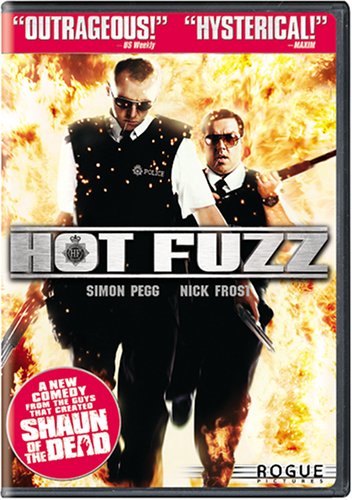 HOT FUZZ – from Edgar Wright and Simon Pegg, the team behind 2004’s wonderful zombie-comedy-romance SHAUN OF THE DEAD – at first resembles a spoof of cop movies. With Pegg as Nicholas Angel, an impossibly brilliant London police officer (not police “man”), who gets sent to a small village because his superiors are tired of the way his good example is making everyone else look bad by comparison. Needless to say, much comedy ensues from watching the supercop reduced to such trivial tasks as tracking down an escaped swan, before he finally uncovers a murderous conspiracy worthy of his talents. But surprise, surprise: the movie takes a big part of its inspiration not just from police-buddy movies (like BAD BOYS II, which is visually referenced in the film) but also from horror films. Continue reading “Hot Fuzz is a Secret Splatter Movie – Borderland Film Review”
HOT FUZZ – from Edgar Wright and Simon Pegg, the team behind 2004’s wonderful zombie-comedy-romance SHAUN OF THE DEAD – at first resembles a spoof of cop movies. With Pegg as Nicholas Angel, an impossibly brilliant London police officer (not police “man”), who gets sent to a small village because his superiors are tired of the way his good example is making everyone else look bad by comparison. Needless to say, much comedy ensues from watching the supercop reduced to such trivial tasks as tracking down an escaped swan, before he finally uncovers a murderous conspiracy worthy of his talents. But surprise, surprise: the movie takes a big part of its inspiration not just from police-buddy movies (like BAD BOYS II, which is visually referenced in the film) but also from horror films. Continue reading “Hot Fuzz is a Secret Splatter Movie – Borderland Film Review”
Disturbia (2007) – Film Review
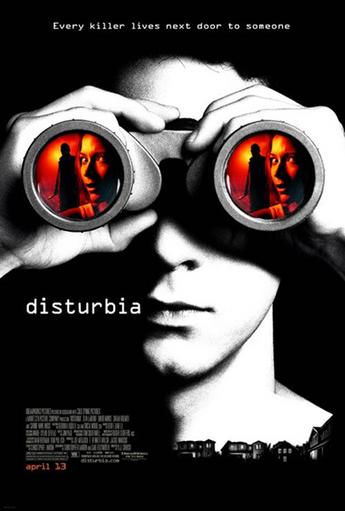 As a thriller, this is mechanical and predictable – barely one-step away from cookie-cutter formulaic – and yet the film actually works up a decent amount of genuine feeling, thanks to the cast of characters. Fear may be in short supply, but you do want to know what happens next – well, you do know what is going to happen next, but you want to see how it happens to these characters.
As a thriller, this is mechanical and predictable – barely one-step away from cookie-cutter formulaic – and yet the film actually works up a decent amount of genuine feeling, thanks to the cast of characters. Fear may be in short supply, but you do want to know what happens next – well, you do know what is going to happen next, but you want to see how it happens to these characters.
The script may not be particularly subtle in its set-up, but it is effective. Kale is an all-around great kid until his dad dies in an automobile accident (while Kale is driving, naturally), whereupon the high school senior morphs into a sullen problem child, ultimately punching out a teacher who upbraids him by mentioning his father. Just shy of eighteen years, Kale lands in house arrest with his widowed mother (Carrie-Anne Moss) and passes the time playing videogames and listening to i-Tunes – until Mom pulls the plug.
Forced to seek excitement elsewhere – and unable to venture from his family property without drawing the police (courtesy of the tracking bracelet on his ankle) – Kale turns binoculars and cameras on the suburban neighborhood around him (which he calls “reality without the TV). At first his interest is mostly on the pretty new girl Ashley (Sarah Roemer), but gradually he comes to suspect that another neighbor, Mr. Turner (David Morse) may be a serial killer. Unable to investigate himself, he sends his best friend Ronnie (Aaron Yoo) into the lion’s den for one of the best suspense sequences in the film, which climaxes with an effective surprise.
Scared for his friend, Kale violates the perimeter of his home, which summons the police (including an officer who just happens to be a cousin of the teacher Kale slugged). Of course, Kale is unable to convince the cops, who see no evidence to support his accusations toward Turner. After the police leave, Kale spots a damning clue on a video shot by Ronnie. Unfortunately, Kale’s mom is in Mr. Turner’s house, begging him not to press charges against her son. With the noose tightening, Turner drops the cat-and-mouse game for more forceful tactics, forcing Kale once again to break the invisible house arrest barrier and confront the killer face-to-face…
There is something weird going on in DISTURBIA, but the weirdness is more a part of the film than a part of the plot. This is a movie that seems to wax nostalgic for the glories of the past yet fears that its target teen audience couldn’t care less. We know the lead character, Kale (Shia LaBeouf), is cool because he wears a Ramones t-shirt, and posters of The Clash and The Doors dot the walls of his room, but the soundtrack does not risk offending the ears of its viewers by actually playing anything by any of those bands. (The only time Kale blasts an oldie out of his i-Pod is when – as a joke – he sends a speakerful of hurt down on a neighbor’s party, in the form of the ghastly, warbly “Lovin’ You” – because he’s jealous that he cannot attend.)
And of course the plot is cribbed from Alfred Hitchcock’s 1954 classic REAR WINDOW, but unlike THROW MOMMA FROM THE TRAIN (which openly referenced STRANGERS ON A TRAIN) and, more recently, Dario Argento’s DO YOU LIKE HITCHCOCK (which acknowledges several Hitchcock films), DISTURBIA presents the story as it were something new, secure in the belief that ticket buyers will not be aware they are receiving re-warmed leftovers. You cannot generate virtuoso levels of suspense when you have characters walking through a familiar situation that they themselves do not recognize – not even in a tongue-in-cheek SCREAM-type fashion – but the surprising thing about DISTURBIA is how well it does work, on its own, not very ambitious level.
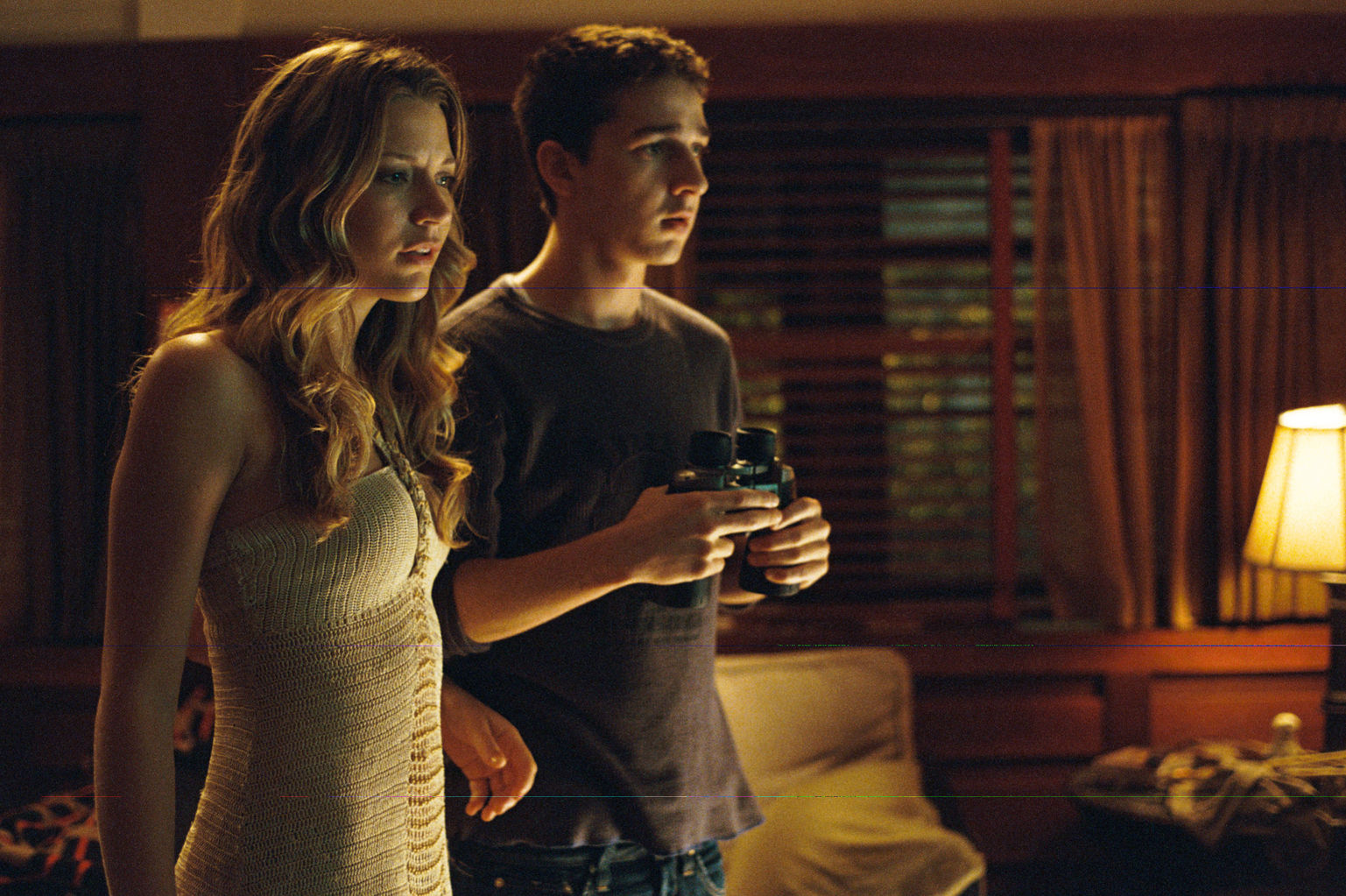
What DISTURBIA has going for it is that Kale, Ronnie, and Sarah turn out to be appealing personalities who resemble human beings with real feelings; they’re not the stupid, horny teen-agers of standard-issue slasher films. LaBeouf and Yoo, in particular, do a good job of playing geeky friends who are not total losers. Roemer is introduced as the typical male fantasy (the beautiful girl next door who undresses with the blinds open and goes on bikini-clad dips in the pool), but gets to emerge as a friend to the two boys before any romance starts to build between her and Kale.
The script seems to want to make some kind of statement about suburbia and about voyeurism. Kale becomes a voyeur not by choice but by predicament, and we’re supposed to think that this element of his incarceration may not be so great for his psyche; all his mind has to feed on is the petty spectacle of his neighbors and their sordid affairs, in which he cannot actively participate. The question is whether he can emerge his essentially decent qualities still in tact, or will his house arrest be as psychologically damaging as a real prison stint.
The film finds the right answer, but it comes midway through the running time, in one of the best scenes: When Ashley confronts Kale about his spying on her, he admits it, but his response reveals that, even at a distance, he has developed a picture of her as a person, not just a hot body.
Unfortunately, this kind of character development has to make way for the plot, which eventually takes over, pushing the Kale-Ashley romance on the back burner (despite being set up as a partner in Kale’s stake-out, Ashley is pretty much off-screen for most of the finale).
Meanwhile, other interesting ideas are abandoned. One of the few new twists on the REAR WINDOW scenario is that, in this case, the suspect befriends Kale’s Mom, which raises interesting questions: Does Kale really believe Mr. Turner is a murderer, or is Kale projecting his suspicions on the neighbor because he fears Mr. Turner will become romantically involved with Kale’s mother and replace his father? The screenplay never bothers to develop the idea once it is introduced; in fact, Turner’s guilt is pretty much a foregone conclusion from the get-go, so there’s not a lot of cleverness that goes into unmasking him.
Director D. J. Caruso pulls out all the stops for the finale, which finally pushes the film over the edge from thriller into the horror abyss, thanks to Turner’s workshop of horror and his basement dump, filled with the putrefying bodies of his victims. The sequence elicits a few decent goose bumps, but the heavy-handed horror approach sometimes beggars belief, as when the cop enters Turner’s darkened house, gun drawn, and casually walks by an obvious hiding place, allowing the killer to jump him from behind. (One imagines that police training would have taught the officer how to avoid this. One also wishes that Hollywood would quit using the “grab-the-head-and-twist” kill method – something that doesn’t look believably lethal unless executed by a martial arts master.)
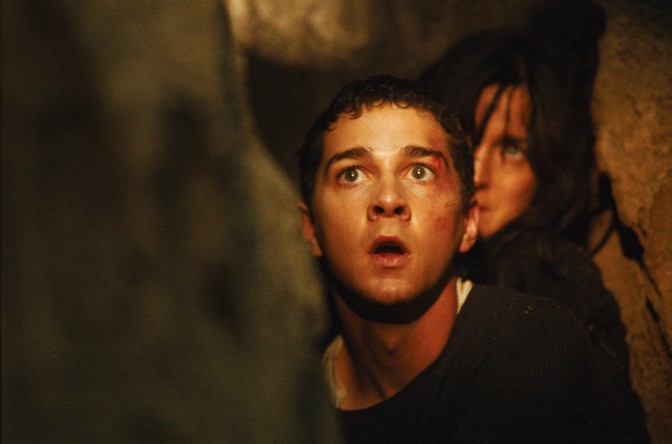
Of course it all ends well. There’s nothing really disturbing about DISTURBIA (unless you’re Hitchcock fanatic mourning the looting of the master’s grave). Fortunately, a film doesn’t have to be a masterpiece to be decent, and despite the soft-sell suspense, the movie delivers enough likable moments to make it a passable entertainment. To enjoy DISTRUBIA, you don’t have to be a teen who has never seen anything like this before, but as far as the filmmakers were concerned, it couldn’t hurt.
DISTURBIA (2007). Directed by D. J. Caruso. Written by Christopher B. Landon and Carl Ellsworth, story by Landon. Cast: Shia LaBeouf, Sarah Roemer, Carrie-Anne Moss, David Morse, Aaron Yoo, Jose Pablo Cantillo Matt Craven, Viola Davis.
RELATED GALLERY: Sarah Roemer Pictures
Grindhouse (2007) – Film Review

This homage to exploitation cinema of decades past seeks is not so much a movie as a gimmick that links together two feature films, plus a handful of faux trailers and advertisements – all appropriately scratched and faded to recreate the experience of attending a second-rate “grindhouse” theatre playing beat-up old prints. As amusing as the concept is, the actual result is a considerable disappointment – a high-tech forgery that lacks the disreputable charm of its models, which were made without the self-conscious affectation on display here. The movie is not without its merits, but it’s safe to say that much of it would have been derisively hooted off the screen at any real grindhouse theatre. In at least one sense, however, the film perfectly captures the grindhouse experience: it promises much more than it delivers.
GRINDHOUSE launches with its best foot forward, a fake trailer called “Machete,” starring character actor Danny Trejo as a Mexican man set up by the people who hired him to assassinate a senator. The brief flurry of outrageous violence, overblown dialogue, and hyperbolic narration yields the perfect recipe for an explosive blast of sheer, giddy fun that the rest of GRINDHOUSE cannot possibly match. Perhaps retrofitted exploitation is better in two-minute doses.
That brief opening exhilaration extends through the first few minutes of “Planet Terror,” written and directed by Robert Rodriguez. With a nod to George Romero’s zombie films like DAWN OF THE DEAD and DAY OF THE DEAD (whose make-up supervisor, Tom Savini, shows up in a supporting role), the story portrays a small town in Texas overrun by zombie-like mutants who have been infected by chemical weapons.
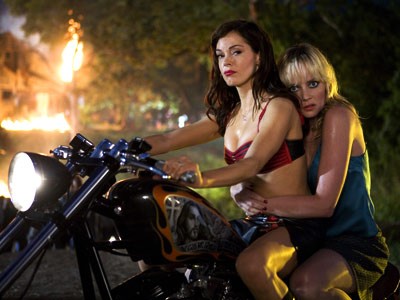
After getting off to a good start, the film bogs down in its narrative meanderings. In way, it too closely emulates its models: it’s boring, and you have to wait for the eruptions of gore and violence to break the boredom. By the time the jokey “Reel Missing” title card flashes on screen and the film jumps ahead as if several scenes have been lost, you’re grateful for the quickstep progress in what had hitherto been building tedium rather than tension.
When the shit hits the proverbial fan near the conclusion, the action blast across the screen in an unapologetic way, but the central visual conceit of actress Rose McGowan with a rifle in place of a leg never really comes off, yielding more derisive chuckles than gasps of excitement. (In the low point, she is supposed to blow smoke away from the recently fired weapon, and it is painfully obvious that she cannot get her mouth anywhere near enough to the barrel to have an effect.) At least the episode is partially redeemed by Rodriguez’s simple but effective music, a pounding, repetitive motif that recurs throughout in different permutations, a la Ennio Morricone and John Carpenter.
Next comes a trio of phony trailers: Rob Zombie’s “Werewolf Women of the S.S.,” Edgar Wright’s “Don’t,” and Eli Roth’s “Thanksgiving.” All are amusing, but none match the delights of the opening “Machete.” Wright’s stands out a bit by virtue of aiming at a target other than cheap exploitation films; its visual style consciously recalls higher-class efforts like 1973’s THE LEGEND OF HELL HOUSE (one actor is a dead ringer for Roddy McDowall, right down to his hair cut).
Roth’s trailer perfectly captures the washed-out look and downbeat “serious” tone of sleazeball horror films, and Zombie gets credit for making a mini-movie that includes both Udo Keir and Nicolas Cage (who, despite being an Oscar-winner, has shown a penchant for ham-handed scenary chewing that would be quite appropriate in a grindhouse movie).
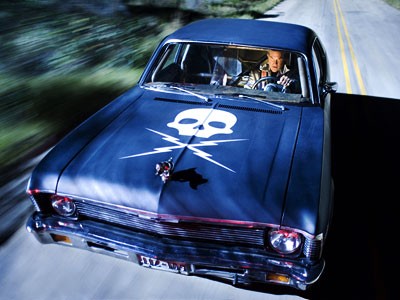
Next up is writer-director Quentin Tarantino’s “Death Proof,” which seems deliberately designed to piss off the target audience. One can admire the nerve it took promise “explicit sexuality and hard-core thrills” and then deliver a feature film that consists mostly of two groups of women sitting around in bars, cars, and cafes, talking about their personal lives; however, that does not make the result entertaining. There may be a sly strategy at work here: the character stuff is so boring that you eagerly look forward to the intrusion of death and violence, which takes the form of Kurt Russell as “Stuntman Mike,” who uses his car to plow through the first group of girls but gets more than he bargains for with the second. Unfortunately, Russell is not really the star of the episode – he is off-screen far too long – so his presence is not enough to save it. But he deserves high-fives all around for taking his despicable woman-killer and turning him into a pathetic loser who whines like a baby when the tables are turned on him.
The other big plus in “Death Proof” is the astounding stunt work by Zoe Bell (who doubled for The Bride in KILL BILL). Here, Bell plays herself, on vacation in America, where she goes on a test drive in a white Dodge (like the one from VANISHING POINT) and hangs off the hood suspended by nothing but a pair of belts. Tarantino gets his camera right in on the action so that you can see it is real, with Bell hanging on for dear life when she and her friends run afoul of Stuntman Mike.
Even so, the chase sequence never matches the thrills of BULLET, and Tarantino overplays his hand: several times, the driver of Bell’s care passes up opportunities to slow down and/or stop, so that Bell could get off the hood and back into the car; this stretches the situation out beyond belief or credibility, delaying what we really want to see – and what Tarantino finally delivers – Bell and friends turning the tables and putting Stuntman Mike in his place. Sadly, the comeuppance arrives, satisfying as it is, cannot possibly justify the time it took getting to it.
In the end, GRINDHOUSE is almost exactly the opposite of what it promises to be. Real grindhouse movies were made on fast schedules with few resources; the exploitation elements were necessary in order to give the audience some kind of entertainment value in exchange for their ticket-buying dollar. Running times were short (88 minutes fit into a single canister, making it cheaper to ship to theatres), and self-indulgent filmmaking was pretty much out of the question.
Rodriguez and Tarantino no doubt have sincere affection for these films, but they come across as posers – not too far from Pat Boone covering a Little Richard song. As much fun as the exploitation action is, it lacks the serious sleaze of the genuine article, and it’s not quite arch enough to amuse as camp. And for all the promise of balls-to-the-wall mayhem, what they deliver here is no more hardcore than anything we’ve seen in their previous films. Hopefully, if GRINDHOUSE II is ever made, the Dynamic Duo will take executive producer roles and hand over the directorial reigns to some young, hungry filmmaker eager to churn out a real grindhouse movie. Either that, or Rodriguez could make the actual feature-length version of “Machete.”
PARTING THOUGHT
Put crudely, one might say that watching GRINDHOUSE is a bit like watching two guys jerk each other off while staring at a Playboy centerfold. In their own minds, they’re having sex with a beautiful woman, and for some reason, they expect us to share their fantasy. But only a blindly loyal fan could be blind to the ugly truth.
TRIVIA
The (actual) trailers for GRINDHOUSE feature shots that are not in the final film (such as Kurt Russell saying “I’m not a cowboy; I’m a stuntman.” According to Rose MacGowan, Tarantino wrote a script for “Death Proof” that was long enough to be a stand-alone feature. Expect lots of deleted scenes (or an extended director’s cut) when the film arrives on DVD.
PLANET TERROR DIRECTOR’S CUT
For DVD, the GRINDHOUSE double bill was divided up into two titles, one for Robert Rodriguez’s PLANET TERROR and one for Quentin Tarantino’s DEATH PROOF. Each offerd an extended unrated director’s cut. The longer version of PLANET TERROR still begins with “Machete” – bogus preview for flick about a Mexican day laborer set up to take the fall for a political assassination – which was probably the highlight of GRINDHOUSE when it was in theatres. Unfortunately, the new cut does not alter PLANET TERROR in any major way – it just adds little bits and pieces throughout – so unless you loved the film to begin with, there’s not much reason to see it again. In case, you were wondering, despite restored footage, the “Scene Missing” title card remains in place, so you still will not learn what Wray said to convince the Sheriff to suddenly trust him.
Hannibal Rising – Horror Film Review
 Over twenty years after “Hannibal the Cannibal” made his film debut in MANHUNTER (1986), the Dr. Lecter saga peters out with this misguided sequel. The absolutely insurmountable problem is that the psychiatric serial killer was most intriguing and frightening as an inexplicable enigma – a walking, talking question mark regarding the nature of evil: Why would someone do this? Answering that question is a bit like a magician revealing the trick behind his magical illusion: the explanation is never as interesting as the mystery, which is thoroughly destroyed in the process.
Over twenty years after “Hannibal the Cannibal” made his film debut in MANHUNTER (1986), the Dr. Lecter saga peters out with this misguided sequel. The absolutely insurmountable problem is that the psychiatric serial killer was most intriguing and frightening as an inexplicable enigma – a walking, talking question mark regarding the nature of evil: Why would someone do this? Answering that question is a bit like a magician revealing the trick behind his magical illusion: the explanation is never as interesting as the mystery, which is thoroughly destroyed in the process.
Building upon a flashback introduced in the novel HANNIBAL (which was abandoned in the film adaptation), HANNIBAL RISING posits that as a boy, Hannibal Lecter saw his sister eaten by soldiers in Lithuania at the end of World War II. It’s a pretty horrible thought but goes nowhere toward explaining how Lecter himself became a cannibal serial killer, so the new storyline – set mostly with Lecter (Gaspard Uliel) as a young medical student – portrays his bloody quest for revenge in the aftermath of the war. The storyline’s sick little joke is that (like HANNIBAL) it will ask you to identify with Lecter as a kind of anti-hero, because his opponents are even worse than he is. Continue reading “Hannibal Rising – Horror Film Review”
Bridge to Terabithia – Borderland Film Review
 Despite an advertising campaign that suggested THE CHRONICLES OF NARNIA: THE LION, THE WITCH & THE WARDROBE (e.g., some teenagers discover a mystical, magical land, where they become heroes), this adaptation of Katherine Paterson’s book emerges as something along the lines a kindlier, gentler American version of PAN’S LABYRINTH. It’s about two junior high school kids who don’t quite fit in; to escape the travails of the schoolyard (including an eighth grade girl who charges younger kids a dollar to get into the rest room), they find an uninhabited area of the nearby woods, where they imagine a magical kingdom called Terabithia. This escape from the pressures of real life leads not only to friendship and fun but also to a wiser understanding of the real world.
Despite an advertising campaign that suggested THE CHRONICLES OF NARNIA: THE LION, THE WITCH & THE WARDROBE (e.g., some teenagers discover a mystical, magical land, where they become heroes), this adaptation of Katherine Paterson’s book emerges as something along the lines a kindlier, gentler American version of PAN’S LABYRINTH. It’s about two junior high school kids who don’t quite fit in; to escape the travails of the schoolyard (including an eighth grade girl who charges younger kids a dollar to get into the rest room), they find an uninhabited area of the nearby woods, where they imagine a magical kingdom called Terabithia. This escape from the pressures of real life leads not only to friendship and fun but also to a wiser understanding of the real world.
The fantasy excursions are relatively minimal, which is a good thing, because the computer-generated special effects (which bring to life walking trees and turn squirrels into the fantasy equivalent of vicious attack dogs) are one of the film’s weakest elements. The movie is on surer footing when the fantastic is left to the imagination or suggested through shadows and sounds. Continue reading “Bridge to Terabithia – Borderland Film Review”